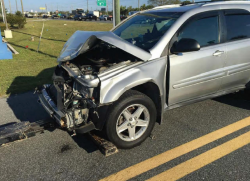
— A GM airbag class action lawsuit has been dismissed after the plaintiffs alleged there is a defect in the calibration of “the software program that controls the [sensing and diagnostic module] SDM to prevent airbag and seatbelt deployment just 45 milliseconds after a crash has begun.”
The class action lawsuit includes millions of General Motors vehicles.
GM allegedly intentionally built a feature into its airbag system that made the system dangerous.
"The 'Class Vehicles' herein include all vehicles in the United States that contain the SDM Calibration Defect that were (1) manufactured, sold, distributed, or leased by Defendants or (2) manufactured, sold, distributed, or leased by Old GM and purchased or leased by Plaintiff or a Class member after July 10, 2009."
The airbag class action alleges that in 1999, GM made the decision to use a software program that prevented airbag and seat belt pretensioner deployment after a period of 45 milliseconds from the beginning of a crash.
This means an airbag will not deploy “in frontal crashes that endure for 45 milliseconds or longer and require airbag deployment or seat belt tightening after 45 milliseconds.”
The plaintiffs claim this is dangerous based on the example of a crash where the vehicle strikes an object and sends the sensing and diagnostic module (SDM) into “wake up” mode. Think of a crash where the vehicle hits something, but then the vehicle hits a second object more than 45 milliseconds later.
The GM airbag class action contends GM was warned in 1999 about the 45-millisecond window and a much longer window of 150 milliseconds was necessary to protect occupants.
According to the lawsuit, the automaker allegedly made its decision, “due to concerns about the potential for airbags to deploy ‘too late’ during an accident,” even though “these concerns were unwarranted given technology that mitigated the risks of ‘late’ airbag deployments.”
The plaintiffs further assert GM chose to "conceal this problem and the pattern of accidents, injuries, and deaths that have resulted from it” in an attempt to avoid “the costs, potential liabilities, and reputational harms.”
GM Airbag Class Action Lawsuit Dismissed
General Motors filed a motion to dismiss the lawsuit by arguing the court had no jurisdiction over claims brought by the non-California named plaintiffs.
And the claims made by California plaintiffs should allegedly also be dismissed because they do not "plausibly allege a defect in their vehicle and because the complaint fails to state a claim."
GM also told the judge the description of the alleged airbag defect is not enough because the plaintiffs "have not adequately supported their claim that the defective software algorithm was incorporated into Plaintiffs’ vehicles."
Judge Jon S. Tigar ruled the GM airbag class action lawsuit provides enough evidence to support a SDM defect existed in 1999. But the judge found the class action lawsuit does not "plausibly allege that the defective software continued to be used decades after it was allegedly placed in GM vehicles."
According to the judge, conclusory statements are not good enough, just as the expert and government reports the plaintiffs use to support their claims are insufficient. Judge Tigar ruled National Highway Traffic Safety Administration and "expert" reports "do not relate to the makes and models of Plaintiffs’ vehicles."
The judge referenced one expert who testified for the plaintiffs but the judge wasn't swayed by the expert opinion.
The judge said the expert referred to alleged airbag defects in 1999, but that doesn't mean there is evidence to show the same sensing and diagnostic modules from 1999 were installed in the 2010-2012 GM vehicles owned by the plaintiffs.
"Because Plaintiffs do not provide facts supporting an inference that the defective SDM installed in model year 1999 still exists in their vehicles, the Court finds that Plaintiffs have failed to allege a plausible claim." — Judge Tigar
Judge Jon S. Tigar dismissed all the non-California plaintiffs for lack of jurisdiction and dismissed the class action lawsuit for failure to allege a plausible vehicle defect.
The judge also found the plaintiffs failed to plead unjust enrichment because no plaintiff pleads they purchased a new vehicle from a GM dealer.
The express warranty claim also fails because none of the plaintiffs presented their GM vehicles for repair as required by the warranty.
"A Plaintiff cannot assert an express warranty claim unless and until the seller has been 'given an opportunity to repair or replace the product.'” — Judge Tigar
And according to the judge, implied warranty claims are dismissed because they are barred by the statute of limitations.
However, the judge ruled the plaintiffs may file an amended lawsuit if they wish, but any additional claims will be for GM customers in California only.
Out of more than 70 named plaintiffs, only three from California remain.
The GM airbag class action lawsuit was filed in the U.S. District Court for the Northern District of California: Ramiro Pereda, et al., v. General Motors LLC, et al.
The plaintiffs are represented by Lieff Cabraser Heimann & Bernstein, LLP, Baron & Budd, P.C., Birka-White Law Offices, and The Miller Law Firm, P.C.




